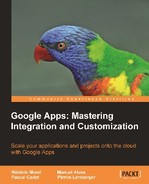Book Description
Scale your applications and projects onto the cloud with Google Apps
- The quickest way to migrate to Google Apps - enabling you to get on with tasks
- Overcome key challenges of Cloud Computing using Google Apps
- Test and optimize Hyperion Planning to perfection with essential tips and tricks
- Full of examples and including a case study: ‘Advanced integration with information systems
In Detail
The advent of Cloud computing and SaaS (Software as a Service) is a major turning point for businesses. Google is one of the pioneers of this approach and the collaborative solution of Google Apps offers a set of office tools (email, calendar, word processing, and spread sheet) for a price, which is two to five times more cost-effective than traditional offerings.
This book is all about making your transition to Google Apps fast and easy. It shows you how to develop a customized adoption path, and takes you through extending and securing your apps while teaching you to manage administrative tasks.
You will begin with the installation of Hyperion Planning and then design Planning applications as per some example user requirements. You will then learn to create the planning objects. The book moves on to explaining important concepts within Hyperion Planning such as data forms, task lists, business rules, validation rules, and workflows, with the help of many real-world examples to maximize your learning. Towards the end of the book, you will cover user provisioning and access rights and budget process management.
The book begins by presenting Google Apps' collaborative and security tools. It then moves on to discuss different ways to extend Google Apps and their integration with development tools like Google App Engine. It also discusses integration with mobile devices like iPhone, Blackberry and others. By the end of the book you will be walked through a pilot project and identify the things that need to be done at the time of full migration. This is done using a case study called ‘Advanced integration with information systems’.
Table of Contents
- Google Apps: Mastering Integration and Customization
- Table of Contents
- Google Apps: Mastering Integration and Customization
- Credits
- About the Authors
- www.PacktPub.com
- Preface
- I. Cloud Computing in the Corporate IS
- Cloud Computing in the Corporate IS
- 1. Google and the Basics of Cloud Computing
- A few words about Google
- Google and Cloud Computing
- Impact of the Cloud on the IS
- The economic impact of Cloud Computing
- Should the Cloud and Google be adopted now?
- Summary
- 2. Why Trust Google?
- II. The Google Apps Platform
- The Google Apps Platform
- 3. Communication Tools
- 4. Collaboration Tools
- Google Docs
- DocVerse
- Google Sites
- Google Video
- Summary
- 5. Security Tools
- 6. Extending the Platform
- III. Advanced Integration with the IS
- Advanced Integration with the IS
- 7. Managing a Google Apps Domain
- 8. Federated Identity and SSO
- 9. Advanced Integration
- 10. Google "Workstation"
- 11. Third-Party Extensions
- IV. Managing a Migration Project to Google Apps
- Managing a Migration Project to Google Apps
- 12. Choosing a Migration Method
- 13. The Pilot Project
- 14. Performing the Migration
- Index
